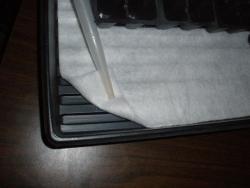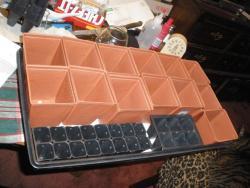<p>You can bottom-water seedlings right in their tray if you put a a fuzzy capillary mat between the pots and the water-holding tray under them. Add only a little water at a time, and the mat will carry that water equally to every pot or cell.</p>
<p> Cotton Flannel Bottom Watering <br /><br />A capillary mat cures over-watering and prevents water-retentive mixes from drowning seedling roots.<br />It also makes bottom watering <u>easier</u> than top-watering, and more uniform!<br /><br />If you find it messy or time-consuming to bottom-water small pots, seedling flats, insert cells or propagation trays, cover the bottom of their solid 1020 tray with cotton flannel or a commercial capillary mat that is absorbent on both sides.<br /><br />Then add only small amounts of water onto the mat, so that the mat is very wet but no standing water is visible. The mat and the grooves in the tray do hold a small reserve of water that each pot pulls from when it needs water.<br /><br />
 <br /> <br />This capillary watering mat spreads the water evenly to all the plants. Every cell and pot gets an equal opportunity to sip only what it needs.<br /><br />If you top-water and flood some pots but miss others, the mat will actively pull water down out of the water-logged pots and transfer that excess water to the drier pots. Capillary action plus gravity maintain similar moisture levels in the bottom of every pot and in the mat. <br /><br />Remove standing water from above the mat with a turkey baster, unless you'll be gone for a week. Figure that the mat and the bottom layer of potting mix are approximately equally soggy or dry, when you consider adding or removing water from the tray.<br /><br />If you use propagation trays or "six-pack" inserts, make sure their bottoms rest on the mats to establish a capillary connection to the soil. <br /><br />
<br /> <br />This capillary watering mat spreads the water evenly to all the plants. Every cell and pot gets an equal opportunity to sip only what it needs.<br /><br />If you top-water and flood some pots but miss others, the mat will actively pull water down out of the water-logged pots and transfer that excess water to the drier pots. Capillary action plus gravity maintain similar moisture levels in the bottom of every pot and in the mat. <br /><br />Remove standing water from above the mat with a turkey baster, unless you'll be gone for a week. Figure that the mat and the bottom layer of potting mix are approximately equally soggy or dry, when you consider adding or removing water from the tray.<br /><br />If you use propagation trays or "six-pack" inserts, make sure their bottoms rest on the mats to establish a capillary connection to the soil. <br /><br />
 <br /><br />You may have to trim the edges or rims off the propagation tray so it doesn't rest on the sides of the 1020 tray instead of on the bottom.<br /><br /><- Bad, the insert rims hold the cells UP, off the mat. Good - the insert rim fits inside the 1020 tray -> <br /><br />
<br /><br />You may have to trim the edges or rims off the propagation tray so it doesn't rest on the sides of the 1020 tray instead of on the bottom.<br /><br /><- Bad, the insert rims hold the cells UP, off the mat. Good - the insert rim fits inside the 1020 tray -> <br /><br /> 
 <br /> <br /><br />Note that the mat does not quite reach the edge of the 1020 tray in the last photo above, and some other photos. That is OK as long as the holes in the bottom of the cells or pots are over the mat (as you can see through the bottoms of the 6-pack cells in the last photo above. <br /><br />If you use several small pieces of fabric to cover the tray, I suggest slight overlaps or bridging wicks so that every piece of matting shares water with every other piece. That way, every plant in the whole tray has water as long as any plant has water. And no cell will have any perched water drowning roots while any cell has less than capillary saturation.<br /><br />I like to assure that the mat can suck every drop out of the grooves in the 1020 tray. To do that, I cut a few strips of cotton flannel or other thick wicking material that will fit down into the drainage grooves. They set up a capillary path from the bottom of a few grooves up to the flannel, so it can always drink the tray dry. <br /><br />If you use this 'flannel method' to bottom-water large potted plants with soluble fertilizer for months, the pots might accumulate salts or unbalanced nutrients (like any bottom-watering method). To cure that, top-water heavily every few months until a good bit of water comes out the bottom of the pots. Remove that salty water with a turkey baster or wet-dry vacuum. Suck the water out of the tray grooves as well, to give the mat more capillary "pull down". That will flush away excess fertilizer. <br /><br />
<br /> <br /><br />Note that the mat does not quite reach the edge of the 1020 tray in the last photo above, and some other photos. That is OK as long as the holes in the bottom of the cells or pots are over the mat (as you can see through the bottoms of the 6-pack cells in the last photo above. <br /><br />If you use several small pieces of fabric to cover the tray, I suggest slight overlaps or bridging wicks so that every piece of matting shares water with every other piece. That way, every plant in the whole tray has water as long as any plant has water. And no cell will have any perched water drowning roots while any cell has less than capillary saturation.<br /><br />I like to assure that the mat can suck every drop out of the grooves in the 1020 tray. To do that, I cut a few strips of cotton flannel or other thick wicking material that will fit down into the drainage grooves. They set up a capillary path from the bottom of a few grooves up to the flannel, so it can always drink the tray dry. <br /><br />If you use this 'flannel method' to bottom-water large potted plants with soluble fertilizer for months, the pots might accumulate salts or unbalanced nutrients (like any bottom-watering method). To cure that, top-water heavily every few months until a good bit of water comes out the bottom of the pots. Remove that salty water with a turkey baster or wet-dry vacuum. Suck the water out of the tray grooves as well, to give the mat more capillary "pull down". That will flush away excess fertilizer. <br /><br /> <br /> <br />I haven't adapted this method to have a deep reservoir, but I think it could be done by draping the mat over some elevated platform or grid and dangling one or both long edges into the 1020 tray, and filling that tray pretty deep before leaving. Or maybe by setting a gallon jug of water 6" above the mat, and trailing a few lengths of cotton twine, parachute cord or other wick from the bottle down to the mat. But test it first to be sure it won't overflow in a few days!<br /><br /><br /> - - - Prevents Perched Water Layers - - - <br /><br />Since the pots are never submerged at all, the bottom half inch of the pot never floods, and a "perched water layer" never forms. The flannel mat's capillary "pull down" power is increased by gravity when the mat is not soaked. This draws fresh air down into the bottom of each cell, so it stays aerobic, sweet, and receptive to roots. <br /><br />Without a mat, an over-watered shallow cell with only baby roots might <u>never</u> drink all the excess water from a perched water layer. With little or no air circulation, the soil mix in the bottom stagnates and becomes anaerobic or hypoxic. Roots are stunted, or drown and rot, or just never penetrate the bottom half of the shallow cell. Fermenting or anaerobic microbes may take over. That's even worse for roots.<br /><br />The situation is even worse if the soil mix is peaty and fine and holds too much water. The only air spaces in the soil are narrow. Even a very thin film of perched water will exclude <u>all</u> air from a mix with too much peat and not enough coarse fiber! In that case, the entire pot or cell may become a perched water layer (no air spaces). <br /><br />A capillary mat lets a peaty mix recover from over-watering much faster, if you remove standing water from the tray and grooves. <br /><br /></p>
<br /> <br />I haven't adapted this method to have a deep reservoir, but I think it could be done by draping the mat over some elevated platform or grid and dangling one or both long edges into the 1020 tray, and filling that tray pretty deep before leaving. Or maybe by setting a gallon jug of water 6" above the mat, and trailing a few lengths of cotton twine, parachute cord or other wick from the bottle down to the mat. But test it first to be sure it won't overflow in a few days!<br /><br /><br /> - - - Prevents Perched Water Layers - - - <br /><br />Since the pots are never submerged at all, the bottom half inch of the pot never floods, and a "perched water layer" never forms. The flannel mat's capillary "pull down" power is increased by gravity when the mat is not soaked. This draws fresh air down into the bottom of each cell, so it stays aerobic, sweet, and receptive to roots. <br /><br />Without a mat, an over-watered shallow cell with only baby roots might <u>never</u> drink all the excess water from a perched water layer. With little or no air circulation, the soil mix in the bottom stagnates and becomes anaerobic or hypoxic. Roots are stunted, or drown and rot, or just never penetrate the bottom half of the shallow cell. Fermenting or anaerobic microbes may take over. That's even worse for roots.<br /><br />The situation is even worse if the soil mix is peaty and fine and holds too much water. The only air spaces in the soil are narrow. Even a very thin film of perched water will exclude <u>all</u> air from a mix with too much peat and not enough coarse fiber! In that case, the entire pot or cell may become a perched water layer (no air spaces). <br /><br />A capillary mat lets a peaty mix recover from over-watering much faster, if you remove standing water from the tray and grooves. <br /><br /></p>
Post a new thread about this blog entry: